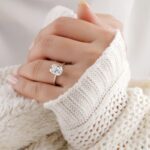Ever noticed how simple, round bands on a person’s ring finger can spark stories of love, commitment, and life journeys? Yep, we’re talking about wedding rings. But hang on, have you ever wondered how this tradition started? How did the concept of sliding a piece of metal onto someone’s finger become synonymous with “forever”? Well, let’s hitch a ride through time and discover the evolution of wedding rings: from ancient civilizations to modern times.
From Egypt’s Reed Rings to Rome’s Gold Tokens
- Ancient Egypt: Picture the majestic Nile, about 5000 years ago. Egyptians made rings from braided hemp or reeds. These rings symbolized eternity, with the hole representing a gateway or door.Did you know? These reed rings weren’t durable, so soon, leather, bone, and ivory stepped in!
- Ancient Rome: Fast forward a bit, and here come the Romans. They believed the ring finger had the ‘vena amoris’ or the ‘vein of love’ connected directly to the heart. They introduced gold as a token of trust and fidelity in marriage. Quite the upgrade, huh?
The Medieval Times & The Renaissance: Diamonds, Posies and More
- Middle Ages: Gold, gems, and intricate designs became popular. But here’s the fun bit: “Gimmel” rings, made of two interlocking parts, were trendy. When engaged, each partner would wear one. Come marriage, and the ring was united, just like the couple. How romantic!
- The Renaissance: “Posie” rings, engraved with short verses or poems, became a rage. Meanwhile, diamond rings made an entrance, but they weren’t for just anyone. They flaunted the status of society’s elite.
From Victorian Extravagance to Modern Minimalism
- Victorian Era: The Victorians loved symbolism. Serpent rings (a symbol of eternity) became the rage. Queen Victoria herself had one! And with the discovery of diamond mines in South Africa, diamond rings became more accessible to the masses.
- Modern Times: Today, wedding rings come in all shapes, sizes, and materials. Titanium, platinum, and recycled metals have joined the list. Ethical and custom-designed rings are gaining popularity, reflecting personal stories and values.
Cultural Infusions: Around the World in Rings
- Asian Touch: In India, the toe ring (or ‘bichiya’) is as significant as the wedding ring. Over in China, puzzle rings were a test for a wife’s loyalty. If she removed it, the husband would know – it falls apart and is tricky to piece back!
- Western Spin: In many Western countries, a simple gold band remains classic. However, with couples becoming more eco-conscious, sustainable options are on the rise.
Frequently Asked Questions (FAQs)
- Why are wedding rings worn on the fourth finger?
- Legend has it that the ‘vena amoris’ or the ‘vein of love’ runs directly from the heart to this finger. A beautiful belief, right?
- Are engagement rings and wedding rings the same?
- Not quite. Engagement rings, often diamond-studded, are given at the proposal. Wedding rings are exchanged during the ceremony.
- Do men have to wear wedding rings?
- It’s personal preference! Traditionally, in many cultures, only women wore them. But today, many men wear them as a symbol of commitment.
Conclusion: The Ring’s Journey and Yours
So, from reed rings by the Nile to sparkling diamonds in a chic Parisian boutique, the evolution of wedding rings mirrors our own journey of love and commitment. More than just metal and stones, they are stories, memories, and promises wrapped around a finger. As times change, so do the rings, but their essence? That remains timeless.
Whatever your ring looks like, it’s the sentiment behind it that truly matters. And remember, as you embark on your journey of love, it’s the story you weave together that will stand the test of time. Just like the wedding ring’s fascinating evolution, wouldn’t you say?






